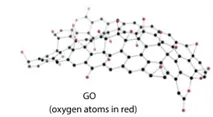
The potential toxicity of graphene oxide
Concerns about graphene oxide have prompted scientists to conduct research into its toxicity. The National Graphene Institute at the University of Manchester has identified variations in the toxicity of graphene oxide in a rodent study. The inhalation toxicity potential varies depending on the width of the graphene oxide sheets. Studies have shown that DNA damage occurs with repeated exposure to high doses.
The team suggested that these findings be taken into account when designing safer two-dimensional materials for commercial applications. Toxicity of graphene oxide would result in granuloma formation (small areas of inflammation) in the presence of micrometer-sized graphene oxide (LGO). However, the rodent data suggests that nano-sized graphene oxide (USGO) may not pose a similar risk as rodent lungs tended to recover quickly from nano-sized graphene oxide exposure.
The thin and light structure of graphene is the main source of concern. This specific structure would allow it to:
- Easily penetrate the lungs (similar to asbestos dust or fiber)
- Cling to internal organs
According to Chemical Watch "although some studies have examined the genotoxic potential of graphene oxide on lung cells in vitro, there is a lack of in vivo lung studies and no consensus yet on the key properties that may lead to toxicity."
What is the origin of these concerns?
It was not until 2021 that concerns about the use of graphene surfaced and began taking traction. Protective masks marketed for protection against COVID-19, were withdrawn from the market by the Canadian authorities. Indeed, these masks contained graphene, and it was found that there was a "potential pulmonary risk that could be caused by the inhalation of graphene particles". As a result, the Anses (Agence nationale de sécurité sanitaire de l’alimentation, de l’environnement et du travail) was asked to evaluate the risks associated with wearing masks containing graphene.
Understanding graphene and its use
Graphene is a word that designates a multitude of structures (monolayer of carbon atoms up to several layers of carbon atoms). Thus, according to the number of layers of graphene and their nature, we find the graphenes mono-sheet, multi-sheet or graphene oxide, all arranged in a hexagonal network. Graphene is a two-dimensional material, prepared from graphite or by chemical vapor deposition or solvothermal synthesis.
Graphene oxide is in the form of sheets of carbon atoms containing oxygenated functions (hydroxy, epoxide, ester, ketone, etc.).

In 2013, the European Union funded a €1 billion "Graphene Flagship" project to foster scientific research on graphene. As a result, the commercial application of graphene was born. The following particular properties of graphene oxide make it attractive for certain applications:
- Large surface area
- Chemical versatility
- Electrical, optical, and thermal properties
In 2021, ECHA has launched a call for tenders to conduct studies on the potential impact of graphene and its oxide on health and the environment under Euon (European Union Nanomaterials Observatory). The objective is to remain transparent about information concerning the safety and markets of nanomaterials.
Graphene has aroused interest among scientists, particularly because of its unusual structure, which gives it electronic and electrical properties and makes it suitable for many applications, coating being a major one. It is a very good conductor of heat and electricity.
What regulations for graphene?
The use of graphene is subject to several regulations.
According to Article 89.2 of the Biocidal Products Regulation (BPR) No. 528/2012, graphene may not be used as a biocidal active substance.
Being a nanomaterial, graphene is subject to REACH n°1907/2006 and CLP n°1272/2008 regulations. Any importer or manufacturer of graphene must register its substances under REACH. Thus, communicating information on the physical and chemical characteristics of the latter. In addition, graphene must meet the requirements of the CLP regulation, it must be classified and labeled according to the criteria of hazard classification. Its use also requires Safety Data Sheets (SDS).
In France, there is a national system for the declaration of nanomaterials (R-Nano). All importers, manufacturers and distributors of graphene, for a quantity of more than 100 grams per year in the nanoparticulate state, are obligated to declare their data in the R-Nano register.
Through its REACH service, EcoMundo supports you in the registration of your substances and ensures the follow-up of your files in the long term. EcoMundo facilitates the traceability of your hazardous substances contained in an article with its SVHC Factory software.
EcoMundo also offers you a tool for optimizing the creation and management of your SDSs in accordance with the latest CLP regulations via SDS Factory.
Want to know more about graphene oxide?
For more information, do not hesitate to contact Christian Freneuil or one of our other experts below:
Chemical Newsletter: Subscribe and receive monthly information and updates on regulations
Need a newsletter to help you keep abreast of regulations and anticipate your short-, medium- and long-term obligations? Chemical Insight is the solution that helps you stay compliant while preventing the obsolescence of your chemical substances. Sign up now!
The potential toxicity of graphene oxide
Concerns about graphene oxide have prompted scientists to conduct research into its toxicity. The National Graphene Institute at the University of Manchester has identified variations in the toxicity of graphene oxide in a rodent study. The inhalation toxicity potential varies depending on the width of the graphene oxide sheets. Studies have shown that DNA damage occurs with repeated exposure to high doses.
The team suggested that these findings be taken into account when designing safer two-dimensional materials for commercial applications. Toxicity of graphene oxide would result in granuloma formation (small areas of inflammation) in the presence of micrometer-sized graphene oxide (LGO). However, the rodent data suggests that nano-sized graphene oxide (USGO) may not pose a similar risk as rodent lungs tended to recover quickly from nano-sized graphene oxide exposure.
The thin and light structure of graphene is the main source of concern. This specific structure would allow it to:
- Easily penetrate the lungs (similar to asbestos dust or fiber)
- Cling to internal organs
According to Chemical Watch "although some studies have examined the genotoxic potential of graphene oxide on lung cells in vitro, there is a lack of in vivo lung studies and no consensus yet on the key properties that may lead to toxicity."
What is the origin of these concerns?
It was not until 2021 that concerns about the use of graphene surfaced and began taking traction. Protective masks marketed for protection against COVID-19, were withdrawn from the market by the Canadian authorities. Indeed, these masks contained graphene, and it was found that there was a "potential pulmonary risk that could be caused by the inhalation of graphene particles". As a result, the Anses (Agence nationale de sécurité sanitaire de l’alimentation, de l’environnement et du travail) was asked to evaluate the risks associated with wearing masks containing graphene.
Understanding graphene and its use
Graphene is a word that designates a multitude of structures (monolayer of carbon atoms up to several layers of carbon atoms). Thus, according to the number of layers of graphene and their nature, we find the graphenes mono-sheet, multi-sheet or graphene oxide, all arranged in a hexagonal network. Graphene is a two-dimensional material, prepared from graphite or by chemical vapor deposition or solvothermal synthesis.
Graphene oxide is in the form of sheets of carbon atoms containing oxygenated functions (hydroxy, epoxide, ester, ketone, etc.).

In 2013, the European Union funded a €1 billion "Graphene Flagship" project to foster scientific research on graphene. As a result, the commercial application of graphene was born. The following particular properties of graphene oxide make it attractive for certain applications:
- Large surface area
- Chemical versatility
- Electrical, optical, and thermal properties
In 2021, ECHA has launched a call for tenders to conduct studies on the potential impact of graphene and its oxide on health and the environment under Euon (European Union Nanomaterials Observatory). The objective is to remain transparent about information concerning the safety and markets of nanomaterials.
Graphene has aroused interest among scientists, particularly because of its unusual structure, which gives it electronic and electrical properties and makes it suitable for many applications, coating being a major one. It is a very good conductor of heat and electricity.
What regulations for graphene?
The use of graphene is subject to several regulations.
According to Article 89.2 of the Biocidal Products Regulation (BPR) No. 528/2012, graphene may not be used as a biocidal active substance.
Being a nanomaterial, graphene is subject to REACH n°1907/2006 and CLP n°1272/2008 regulations. Any importer or manufacturer of graphene must register its substances under REACH. Thus, communicating information on the physical and chemical characteristics of the latter. In addition, graphene must meet the requirements of the CLP regulation, it must be classified and labeled according to the criteria of hazard classification. Its use also requires Safety Data Sheets (SDS).
In France, there is a national system for the declaration of nanomaterials (R-Nano). All importers, manufacturers and distributors of graphene, for a quantity of more than 100 grams per year in the nanoparticulate state, are obligated to declare their data in the R-Nano register.
Through its REACH service, EcoMundo supports you in the registration of your substances and ensures the follow-up of your files in the long term. EcoMundo facilitates the traceability of your hazardous substances contained in an article with its SVHC Factory software.
EcoMundo also offers you a tool for optimizing the creation and management of your SDSs in accordance with the latest CLP regulations via SDS Factory.
Want to know more about graphene oxide?
For more information, do not hesitate to contact Christian Freneuil or one of our other experts below:
Chemical Newsletter: Subscribe and receive monthly information and updates on regulations
Need a newsletter to help you keep abreast of regulations and anticipate your short-, medium- and long-term obligations? Chemical Insight is the solution that helps you stay compliant while preventing the obsolescence of your chemical substances. Sign up now!







